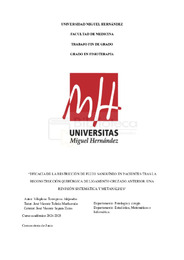Please use this identifier to cite or link to this item:
https://hdl.handle.net/11000/37618Full metadata record
| DC Field | Value | Language |
|---|---|---|
| dc.contributor.advisor | Toledo Marhuenda, José Vicente | - |
| dc.contributor.advisor | Segura Heras, José Vicente | - |
| dc.contributor.author | Vilaplana Torregrosa, Alejandro | - |
| dc.contributor.other | Departamentos de la UMH::Patología y Cirugía | es_ES |
| dc.contributor.other | Departamentos de la UMH::Estadística, Matemáticas e Informática | es_ES |
| dc.date.accessioned | 2025-10-03T07:30:16Z | - |
| dc.date.available | 2025-10-03T07:30:16Z | - |
| dc.date.created | 2025-05-27 | - |
| dc.identifier.uri | https://hdl.handle.net/11000/37618 | - |
| dc.description.abstract | Objetivo. Evaluar la eficacia del entrenamiento con restricción del flujo sanguíneo (BFR) frente a intervenciones sin BFR, aplicado tras la reconstrucción del ligamento cruzado anterior (RLCA) midiendo la fuerza, hipertrofia y funcionalidad de rodilla. Métodos. Se realizaron búsquedas en PubMed y Embase entre noviembre de 2024 y marzo de 2025 El riesgo de sesgo se evaluó mediante la herramienta Cochrane Risk of Bias y la calidad metodológica con la escala (PEDro). Resultados. La búsqueda arrojó 30 ensayos clínicos aleatorizados. Un total de 8 estudios fueron incluidos en el análisis cualitativo y 5 en el cuantitativo. El grupo BFR mostró mejoras significativas en la fuerza (p= 0.031), habiendo una disminución significativa de la fuerza extensora en el grupo sin BFR (SMD = 0.77; IC 95%: [0.36, 1.19]). Respecto a la hipertrofia, se observaron aumentos relevantes en el grosor del cuádriceps (SMD = 0.57; IC 95%: [-0.93,-0.21]) sin diferencias significativas (p=0.314). Se hallaron beneficios en la funcionalidad (SMD = -1.94; IC 95%: [-3.31,-0.60]), sin diferencias entre grupos (p=0.082) a favor del BFR (SMD= -2.91; IC 95%: [–5.21, -0.60]). Conclusión: El BFR puede ser una estrategia útil para optimizar la rehabilitación postquirúrgica del LCA, especialmente en las fases iniciales. No obstante, se requieren más estudios con mayor homogeneidad metodológica. | es_ES |
| dc.description.abstract | Objective: To evaluate the effectiveness of blood flow restriction (BFR) training compared to non-BFR interventions following anterior cruciate ligament reconstruction (ACLR), by measuring knee strength, hypertrophy, and functionality. Methods: Searches were conducted in PubMed and Embase between November 2024 and March 2025. Risk of bias was assessed using the Cochrane Risk of Bias tool, and methodological quality was evaluated using the PEDro scale. Results: The search yielded 30 randomized controlled trials. A total of 8 studies were included in the qualitative analysis and 5 in the quantitative analysis. The BFR group showed significant improvements in strength (p = 0.031), while a significant decrease in extensor strength was observed in the non-BFR group (SMD = 0.77; IC 95%: [0.36, 1.19]). Regarding hypertrophy, relevant increases were observed in quadriceps thickness (SMD = 0.57; 95% CI: [-0.93, -0.21]), though not statistically significant (p = 0.314). Benefits in functionality were found (SMD = -1.94; 95% CI: [-3.31, -0.60]), with no significant differences between groups (p = 0.082), in favor of BFR (SMD = -2.91; 95% CI: [–5.21, -0.60]). Conclusion: BFR may be a useful strategy to optimize post-surgical ACL rehabilitation, especially in the early phases. However, further studies with greater methodological homogeneity are needed. | es_ES |
| dc.format | application/pdf | es_ES |
| dc.format.extent | 49 | es_ES |
| dc.language.iso | spa | es_ES |
| dc.publisher | Universidad Miguel Hernández | es_ES |
| dc.rights | info:eu-repo/semantics/openAccess | es_ES |
| dc.rights | Attribution-NonCommercial-NoDerivatives 4.0 Internacional | * |
| dc.rights.uri | http://creativecommons.org/licenses/by-nc-nd/4.0/ | * |
| dc.subject | Blood Flow Restriction Therapy | es_ES |
| dc.subject | ACL | es_ES |
| dc.subject | Occlusion training | es_ES |
| dc.subject | Vascular occlusion | es_ES |
| dc.subject | Anterior cruciate ligament injury | es_ES |
| dc.subject | Knee ligament injury | es_ES |
| dc.subject.other | CDU::6 - Ciencias aplicadas | es_ES |
| dc.title | Eficacia de la restricción de flujo sanguíneo en pacientes tras la reconstrucción quirúrgica de ligamento cruzado anterior. Una revisión sistemática y metaanálisis. | es_ES |
| dc.type | info:eu-repo/semantics/bachelorThesis | es_ES |

View/Open:
TFG VILAPLANA TORREGROSA ALEJANDRO .pdf
1,36 MB
Adobe PDF
Share:
.png)
